Click the image above for a hi-res gallery of the Porsche Boxster RS 60
Our colleague Chris Tutor recently took the Porsche Boxster RS 60 Spyder for a few quick turns around Barber Motorsports. A tad more powerful than the Boxster S, and filled with red leather, he discovered it was plenty of car on the closed circuit. We recently had a chance to get the special edition RS 60 off the track and onto the back roads of Rhode Island and Connecticut, and got to see what the car could do on twisting country lanes – and unexpectedly, in the rain. The likewise unexpected result: damn near perfection. Follow the jump to find out how,and check out the gallery of hi-res and sometimes very damp images below.
Our colleague Chris Tutor recently took the Porsche Boxster RS 60 Spyder for a few quick turns around Barber Motorsports. A tad more powerful than the Boxster S, and filled with red leather, he discovered it was plenty of car on the closed circuit. We recently had a chance to get the special edition RS 60 off the track and onto the back roads of Rhode Island and Connecticut, and got to see what the car could do on twisting country lanes – and unexpectedly, in the rain. The likewise unexpected result: damn near perfection. Follow the jump to find out how,and check out the gallery of hi-res and sometimes very damp images below.
All Second Drive gallery photos Copyright ©2008 Sergio Jurado / Weblogs, Inc.
The Porsche Boxster RS60 Spyder we drove costs $59,065. For that money, you do not get navigation. You do not get power seats. You do not get an iPod hookup, nor a manual trunk release, nor an 'Auto' setting for the headlights (which, along with that trunk release, will be a factor later on in our story). At times, the Plexiglass windscreen between the seats squeaks. When the aluminum-backed seats are pushed all the way back against the carpeted rear bulkhead, they might squeak as well. The red and metallic dash is almost constantly reflected in the steeply raked windshield.
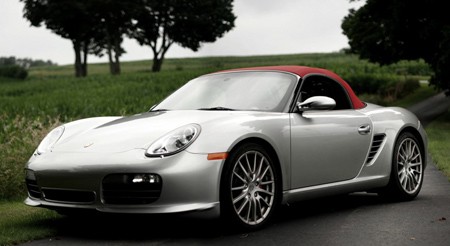
And then there's the matter of purity. This particular blogger had a thing about Porsches: you either had a 911, or you had... whatever it is you had. We owned a 993 for a while, and simply could not understand how anyone could leave the Porsche dealership with anything other than The Icon. We didn't look down on Boxster drivers... we simply didn't quite... get it.
Now we do.
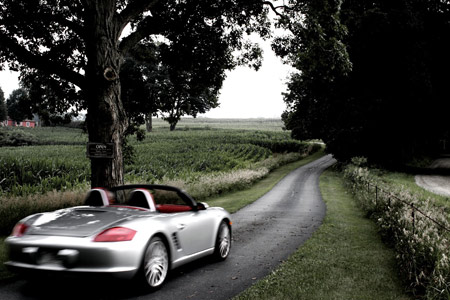
Porsche can charge you $59,065 for the Boxster RS 60 Spyder because, for all it doesn't come with, it comes with one thing worth every red pfennig: deliciously coordinated delivery of sublimely engaging driving sensations you will not find anywhere else outside of Porsche. It's been said ad infinitum. I will say it again: no other automaker has distilled the thrill of driving as perfectly as Porsche.
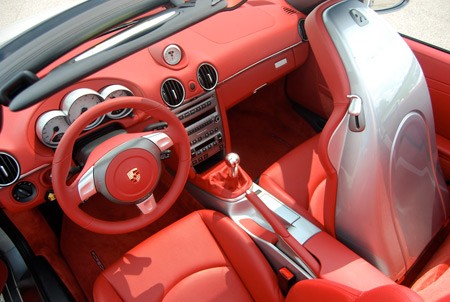
The steering wheel is the perfect size, in the perfect place. There are no buttons on its spokes for cruise control or volume or the dash information display. It says, "I am not a universal remote. I am for driving."
The seats – gasp -- leave one plenty of room in the cabin, something I couldn't entirely say of the last 911 I drove. The sports recliners also hug perfectly -- even during those Over-the-Road hauls -- in a way that keeps your lower back, kidneys, and rump far too busy being comfortable to bother you.
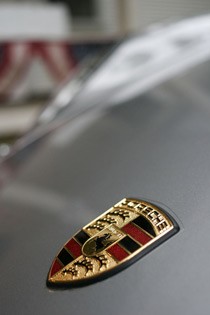
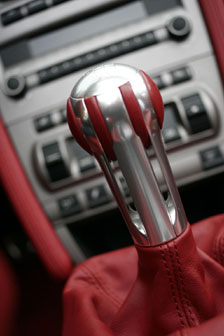
There is a Terminator-esque gearshift, a proper 6-speed snickity-snick dealy-o, that begs you to rest your hand on it. And when it's time to shift... egads... thank you, mother, can I have another?
There's that exhaust note. Like that third bowl of porridge, it is just right. It never goes away, but it never drones. And when you invite it into the cabin through the subtle flexing of your right calf, it fills the interior, fills your ears, fills the spaces between your solar plexus and coccyx with a magnificent resonance.
Everything we've discussed so far you can enjoy standing still. When it's time to move... ah yes, there's that aerospace precision we have come to expect from Porsche, the 1:1 ratio of driving input to engine and vehicular output. There are driver's cars that are more visceral, more luxurious, more thrilling. We've driven most of them. Not a one provides the same we-could-do-this-all-day driving experience.
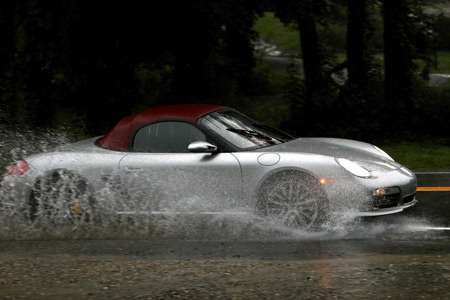
What about that English bulldog sniffing around Porsche's marked territory, the V8 Vantage? We drove the '08 Vantage for two weeks all over Europe, and it is an undeniably terrific car. But in its luxurious leanings, it is just a hair less taut than the Porsche, less tight by one iota when it comes to the asphalt equivalent of Chutes and Ladders. Our colleague Damon Lavrinc recently tested the 2009 Vantage and came to the same conclusion. Which is no slight at all to the Vantage. But Porsche created this game. And still rules it.
Yet believe it or not, we came not to gush over the RS 60. We are simply forced to praise it.
The wet, green summertime woods of New England, threaded with an intertwined mess of 2-lane roads, were perfect for the car. At a stubby 14 feet, a little over 3,000 pounds, with 303 hp, 251 ft-lb, and a beautifully sorted suspension, cornering is done as it's meant to be. That is, a human being in charge of steering, throttle, and shifting, with no worries about The Walloping Weight Shift somewhere around turn-in, or heaven forbid, exit.
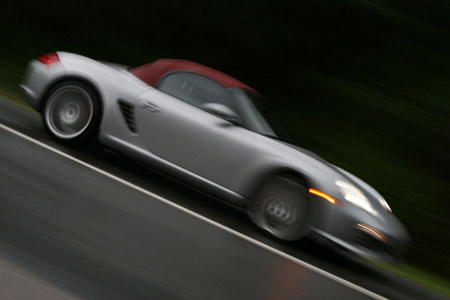
Hit the gas and the car goes... but it doesn't GO! And it's not supposed to, so as not to upset its jealous bigger brother. The RS 60 has just enough power for you to really get on it, exploit it around turns and down straights. It's plenty, especially if you appreciate the driving investment. Get on a 911 Turbo the same way, and the only things you'll be exploiting are the limits of your insurance premiums, both health and auto. For B-road fun, the Boxster is everything it needs to be.
And now to the issue of those non-Auto lights and no-manual trunk release. The only blight we endured from the special edition Boxster was what was required when the battery went dead, as it did when a valet left the lights on. Pay close attention:
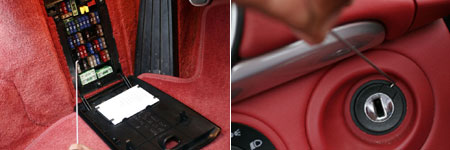
You can't remove the key from the ignition when the battery is dead. To do so, you pull the cover off the fuse box in the driver's footwell. You remove the 6-inch long sliver of a metal rod with a bend at one end. You place the bend inside a tiny hole in the plastic ignition lock surround, and pull out a frighteningly tiny sliver of plastic. Turn the key to the left, then place the other end of that metal rod inside a hole in the ignition lock, and that releases the key. If you've managed not to lose that Lilliputian piece of plastic, you replace it in its housing.
So you've got your key back. But you still can't get to the battery. Since there's no manual hood release, you have to go back to the fuse box, extending a specially marked red fuse. Place the positive jumper cable on that fuse, the negative cable on the door hinge, but don't pull the automatic hood release, because that still doesn't work. You have to press the hood release on the key. Then the hood pops open.
Then you cart the charge box to the front of the car and hook it to the battery. Then you get back in the car and it starts, and lights up like the Sydney Harbor Bridge at New Year's since the low voltage has thrown things out of whack.
Then you drive. And all is, yes, forgiven.
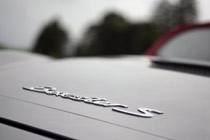
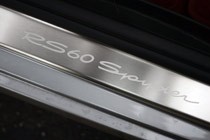
Our verdict: personally, we'd still take a 911, but not for puritanical reasons. We happen to like the 911 better, and we wouldn't mind the extra power for the straights. But after seven hours, two hundred miles, a Woodstock Burger, and two enormous scoops of ice cream in the RS 60, we have just one thing to say about it: We-Li-Kit.

All Second Drive gallery photos Copyright ©2008 Sergio Jurado / Weblogs, Inc.

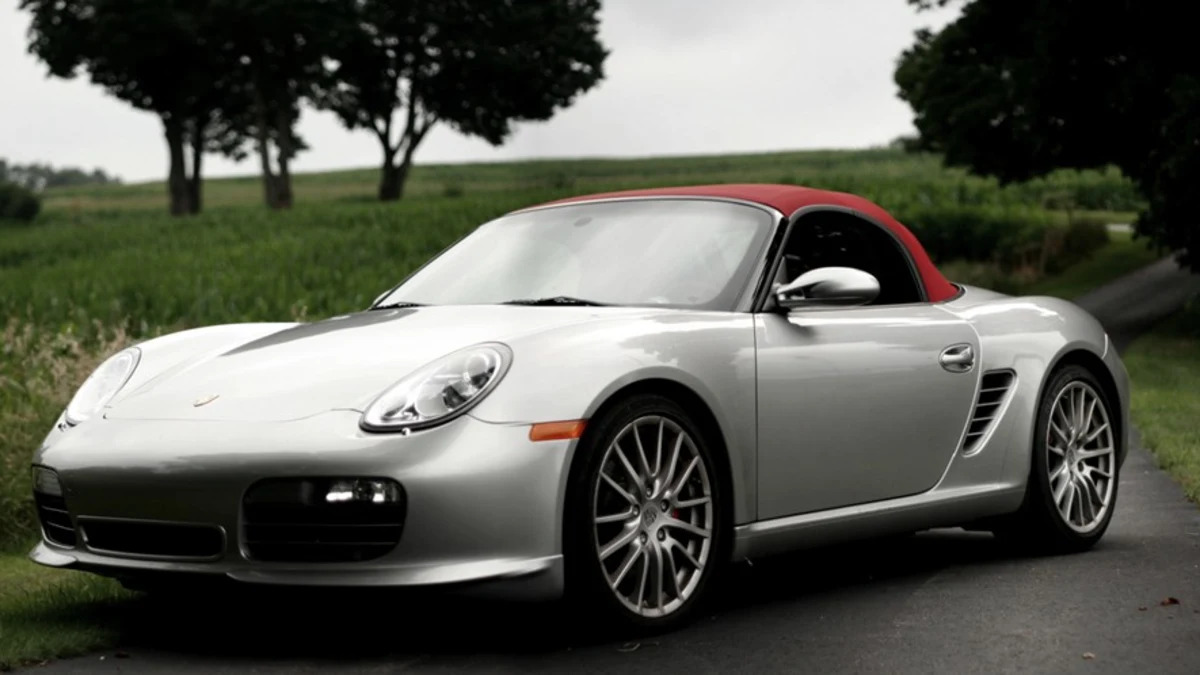

Sign in to post
Please sign in to leave a comment.
Continue